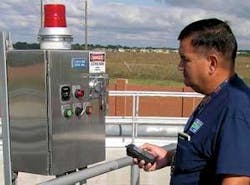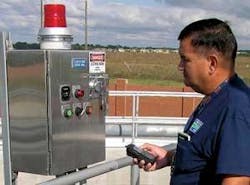Saving Time and Money with Cell-Based Data Collection
by Jim Gillam, ElizaBeth Reeves, and Lonnie Cox
In 2004, Severn Trent Services recognized the severity of its paperwork problem — maintaining monthly log sheet data for each facility it operates, which comprises 69 water plants, 55 wastewater plants and 162 lift stations for nearly 180 customers, of which 120 are Municipal Utility Districts (MUDs) in the Houston, Texas, area.
Manually transcribing log sheets into Excel spreadsheets for the monthly reports required by the Texas Commission on Environmental Quality (TCEQ) was exceptionally tedious and time consuming. Each of Severn Trent's assistant managers (today there are 16) spent 1 to 2 days per month generating the reports. There were also problems with transcription errors and occasionally inaccurate data. Severn Trent needed a way to leverage technology to help its employees work more efficiently while providing more service for its customers.
As part of a separate process, Severn Trent was also manually entering consolidated monthly report data into other spreadsheets to report pumpage to the Houston area's water authorities and to manage permit amounts for the local subsidence districts, which oversee the volume of water being pumped from wells. With 113 water systems and 80 permits, this was also a time-consuming process, and it was difficult to stay on top of situations where the company might risk being fined for pumping more than a permit's allotment. The company recognized its need for a system that would flag these situations and allow it to file permit amendments in time.
Automating Data Collection via Cellphone
In 2004, Severn Trent Services' Gulf Region agreed to become a beta test site for a new water utility management system being developed by BirdNest Services Inc. (Houston, TX). Severn Trent believed the system could help it manage data gathering and reporting more efficiently and effectively.
The Software-as-a-Service system did not require installation of any software or purchase of any equipment other than cellphones, which, in Severn Trent's case, operators were already using. Severn Trent paid a one-time setup fee, plus an annual company access fee and a monthly subscriber fee based on the number of users entering data into the system.
To use the system, the operator logs in to the central computer via cellphone using a unique ID number and password. Then the computer downloads the operator's profile, including areas, facilities and other data needed to perform in the field.
The operator selects a facility from a menu, and is then prompted through a series of menus customized for the facility on which he's reporting. The phone carries out rudimentary data validation and ensures all data is collected.
Once an operator has entered all required information and reviewed the entries, pressing the Send button time-stamps the data and transmits it to the central computer where it is processed and posted onto the facility's electronic log sheet. If an operator is out of cell tower range, the phone stores the data until it comes within range and then transmits it automatically. After all data for a facility has been entered and transmitted, that facility is flagged in the main list, so the operator can track which facilities have been checked and which ones remain.
The collected data is available via the Internet to any authorized users. The system includes digital log sheets plus a report generator that shows both tabular and graphed data. Severn Trent can export the data to Excel spreadsheets to produce its standard operational and compliance reports.
From Beta Test to Comprehensive Implementation
Severn Trent currently has about 60 to 70 operators sending almost 100,000 data points per month. In addition to the operators, about 120 additional users access the data to generate reports. The system produces the key monthly TCEQ reports in a fraction of the time it used to take: Instead of 16 assistant managers transcribing data into spreadsheets and running separate reports for each facility they manage, they can now run a single report from data that has already been captured. The data is transferred from that report to a Severn Trent template, populating all of the districts at one time. The report is then formatted for TCEQ. What used to take one to two days per assistant manager has been reduced to less than 1.5 hours.
Adding Applications: Subsidence Permits
Because subsidence is an issue in the Gulf Coast area, most of Severn Trent's water systems operate under permits from a local subsidence district. Users purchase a certain amount of permitted water and can be fined if more than the permitted limit is accidentally pumped. If Severn Trent recognizes that water usage under a permit is higher than anticipated before the permit has been exceeded, it can file an amendment, which is far less expensive than paying the fine for overuse.
For years, environmental specialist ElizaBeth Reeves and her team have monitored monthly flows and managed the annual reports for the subsidence districts by using a large Excel spreadsheet set up something like a checkbook. The data had to be manually entered from the monthly operating reports that had already been created for TCEQ. But with the data management capabilities of the new Internet-based system, the pumpage data can be captured automatically. At the end of each month, the system runs scheduled area reports, which provide the data to the Excel templates, which in turn update each of the 80 subsidence district permits.
Conclusion
Today, Severn Trent operators use their cellphones to enter data for water and wastewater plants and lift stations. The BirdNest system saves the company considerable administrative time and money because it helps eliminate duplicate data entry and manual data transcription. It also helps collect more accurate data, avoid errors, and decrease the time it takes to respond to problems. It provides an extra level of efficiency and effectiveness that allows employees to do their jobs better, which in turn satisfies the company's clients — and that gets voiced in the community and opens new opportunities for Severn Trent.
About the Authors:
Jim Gillam is a regional general manager with Severn Trent Services. ElizaBeth Reeves is an environmental specialist with Severn Trent Services. Lonnie Cox is an assistant manager with Severn Trent Services.




